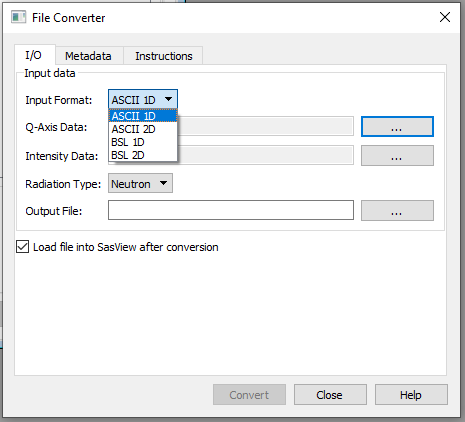File Converter Tool
Description
This tool converts file formats with the Q data and Intensity data stored in separate files, into a single CanSAS (XML) or NXcanSAS (HDF5) file.
It can also convert 2D BSL/OTOKO files into a NXcanSAS file.
Supported input file formats (examples may be found in the /test/convertible_files folder):
- Single-column ASCII data, with lines that end without any delimiter, or with a comma or semi-colon delimiter
- 2D ISIS ASCII formatted data
- 1D BSL/OTOKO format data
- 2D BSL/OTOKO format data
Supported output file formats:
Using the Tool
- Select the files containing your Q-axis and Intensity-axis data
- Choose whether the files are in ASCII 1D, ASCII 2D, 1D BSL/OTOKO or 2D BSL/OTOKO format
- Choose where you would like to save the converted file
- Optionally, input some metadata such as sample size, detector name, etc
- Click Convert to save the converted file
A checkbox allows you to decide if SasView should automatically load in the converted files.

Files With Multiple Frames
If a BSL/OTOKO file with multiple frames is selected for the Intensity-axis file, a dialog will appear asking which frames you would like converted. You may enter a start frame, end frame & increment, and all frames in that subset will be converted. For example, entering 0, 50 and 10 will convert frames 0, 10, 20, 30, 40 & 50.
To convert a single frame, enter the same value for first frame & last frame, and 1 as the increment.
Warning
Conversion of multi-frame 2D BSL files is not working properly in this release.
CanSAS XML files can become quite large when exporting multiple frames to a single file, so there is an option in the Select Frame dialog to output each frame to its own file. The single file option will produce one file with multiple <SASdata> elements. The multiple file option will output a separate file with one <SASdata> element for each frame. The frame number will also be appended to the file name.
The multiple file option is not available when exporting to NXcanSAS because the HDF5 format is more efficient at handling large amounts of data.
Note
This help document was last changed by Steve King, 02Apr2020